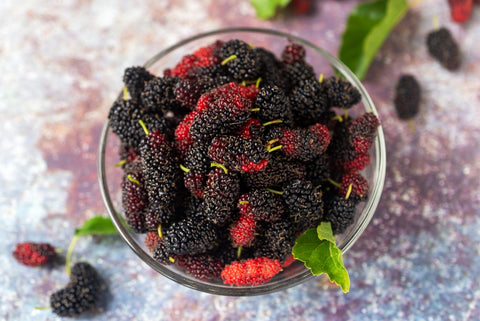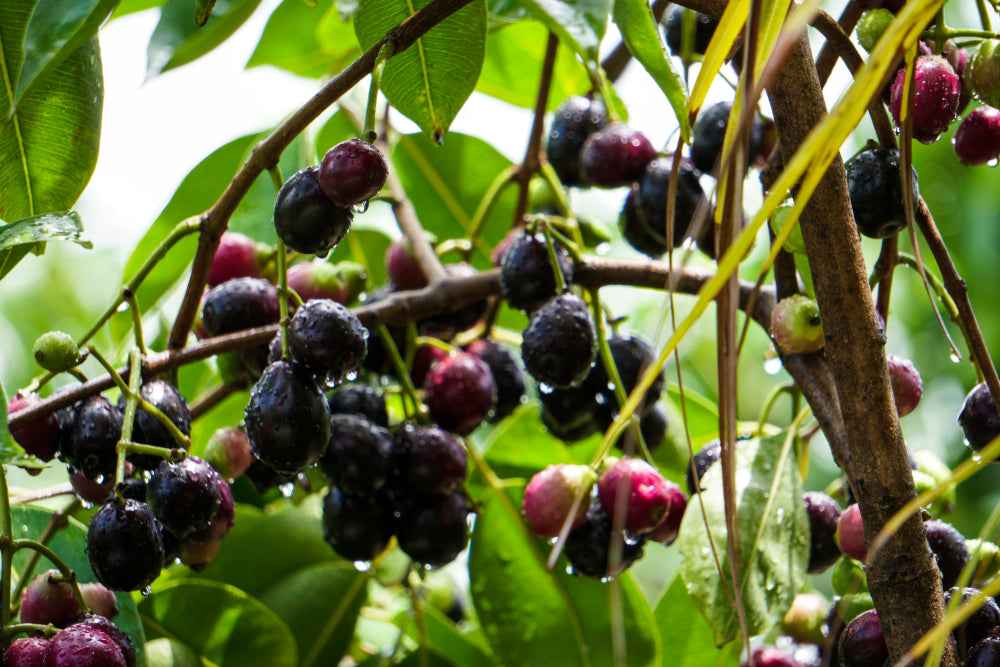When it comes to growing berries in India, you may not necessarily be able to grow the more mainstream ones like raspberries and blueberries. However, there is an abundance of India berry types that you can successfully grow to eventually consume.
Here is a list of these berries and their respective benefits!
• 8 Indian Berry Types You Can Successfully Grow
1. Ber (Indian Jujube)

The Indian Jujube, also commonly known as Ber, is a round, yellow-orange fruit that grows on a tree with oval leaves of a dark green hue. The flowers on this tree grow to become a shade of greenish-white or yellow and mature to produce the Ber.
a. When Does Ber Grow?
Planting for Ber is usually done in the beginning of the monsoon season. Most of these trees are pretty fast growing and will have flowers in the same year they were planted.
Sometimes, these flowers could produce fruits in that year itself. However, other times, it will be during the second year that the tree bears produce.

b. Benefits of Ber
This Indian berry comes with a wide array of benefits and nutritional value. The fruit has high antioxidant properties and can help rejuvenate and keep the skin healthy.
Some extracts of the fruit also help cure wounds faster. Additionally, Ber also potentially aids digestion.
Moreover, the Indian Jujube has been proven to be helpful for heart health as it lowers blood cholesterol levels. Some claim that it also helps prevent and reduce anxiety and insomnia.
2. Jamun (Java Plum)

When many talk about berries from India, one of the first few that pop into mind is the Jamun! Highly beloved and beneficial, Jamun is undoubtedly one of those Indian berries that just takes the name for being super popular.
The Jamun tree is found throughout our country and subcontinent. Mythologically, it is also considered sacred and important to Lord Krishna due to which it can be found near many Hindu temples.
a. When Does Jamun Grow?
Whenever its planted, its growing pattern remains pretty consistent with flowers blooming some time around April in most states. Eventually, it is during rainy seasons that the Jamun fruit is ready to harvest.
Following full bloom, the fruits take around 3-5 months to fully ripen.

b. Benefits of Jamun
Jamun has been used in traditional medicine to treat various common illnesses. The extract of this berry has also shown good results when it comes to reducing blood sugar levels.
Not only are the fruits of this tree beneficial but also every other part of it that you could imagine! The bark, leaves, fruit, fruit extracts all have their own set of benefits.
3. Amla (Indian Gooseberry)

Craving something sour but also want to eat super healthy? Amla, also known as Indian Gooseberry, has you absolutely covered! Widely regarded as a superfruit and a great source of vitamin C, the Amla is an Indian berry that just doesn't know how to disappoint.
a. When Does Amla Grow?
Since Amla plants are pretty hardy, they can easily be grown in various regions of our country. But mainly, they are a pretty big source of produce to sell for farmers in Rajasthan.
Their peak harvesting season begins in the end of July and lasts up until December. In different regions, this harvesting season occurs at different times, but usually it is in that particular timeline.

b. Benefits of Amla
Amla consists of super high levels of vitamin C which boost immunity and help the body recover faster. It also has some levels of a chemical that has been proven to improve and boost memory.
Often, this Indian berry also has positive effects on blood sugar level and helps those with type 2 diabetes. Additionally, this berry also helps improve eyesight and aid digestion.
4. Karonda (Carandas Plum)

Karonda is an indigenous shrub in India and is often revered as a multi-functional and exotic Indian berry. It is known for its whitish-pink, small berries and low-growing shrubs.
a. When Does Karonda Grow?
The Karonda is a slow-growing but low-maintenance plant. Once planted, it will give you unripe fruits by the month of May. But in order to harvest fully ripe fruits, you will have to wait till August.

b. Benefits of Karonda
These whitish-pink berries from India have the ability to potentially reduce inflammation, act as an antioxidant, and also potentially reduce fever when used the right way.
Moreover, these berries are also undergoing testing for potentially having cancer-reducing properties that would absolutely baffle and change the world of medicine.
5. Phalsa (Indian Sherbet Berry)

This wonderful and stunning fruit was actually found for the very first time in Varanasi, India following which it was taken to other countries by Buddhist scholars. In its shape and size, this Indian berry is much like grapes. But in the benefits that it provides, it easily exceeds many other fruits.
a. When Does Phalsa Grow?
The harvesting season for this fruit is rather shorter than the rest. As a summer fruit, the Phalsa is ready to pick and harvest during peak summer months, i.e. from March through April in the south and May to June in the north.

b. Benefits of Phalsa
Another berry that has a vast array of medical benefits is the Phalsa. These purple-red berries from India are said to have potential effects on lowering blood sugar levels. Many claim that this fruit also has the power to stop abnormal cell growth and thus reduce chances of cancer, namely in women.
Additionally, there are also claims that this Indian berry plays a vital role in reducing depression.
6. Kokum (Goa Butter Tree)

The Kokum tree mainly grows on the Western coast in India but can be found in various other regions as well. If you've been to popular tourist spots like Goa, you must have tasted at least one drink made out of Kokum, and the taste is absolutely refreshing!
This versatile Indian berry has various uses and is beloved for its culinary adaptability.
a. When Does Kokum Grow?
Kokum is often regarded as an important spice tree and fruit that grows in India. It does well in hot, humid climates and partial shade. The tree is rather hardy and can withstand countless growing conditions, and its fruits become ready to harvest in the months of April to June.

b. Benefits of Kokum
Kokum fruits make for super healthy fruits for weight loss! They aid in weight loss and enhance digestion. They also have anti-inflammatory properties that could help with any inflammation in the body.
Moreover, there are claims that Kokum fruits can help in reducing body cholesterol levels and keep heart diseases away.
7. Rasbhari (Cape Gooseberry)

In different parts of the world, Rasbhari is called different names depending on where it is being cultivated and grown. These berries are a stunning golden-orange color and have a very unique, tart taste.
a. When Does Rasbhari Grow?
Also known as Goldenberry, this berry grows in India during spring months. Since India does not have a defined 'spring' season, which is during March and April.

b. Benefits of Rasbhari
Rasbhari is known for its abundance of vitamin C. This makes it an excellent sources for boosting immunity. Naturally, this makes it a brilliant eyesight enhancer as well. It prevents cataract and degeneration of eyesight over time.
Additionally, it also control blood pressure and strengthens bones and joints.
8. Shahtoot (Mulberries)

Mulberries are often regarded as one of the most nutritious and delicious berries fit for consumption. They grow as hanging berries on deciduous trees and make for stunning visual displays along with being nutrient powerhouses. They are often referred to as the "King's" or "Superior" mulberries.
a. When Do Mulberries Grow?
The main harvesting season for Mulberries is from August to September. The harvest season is rather short and people eagerly await it. This berry resembles blackberries and changes color from a deep red to glossy black when fully ripe.

b. Benefits of Mulberries
Mulberries also come with an array of medicinal benefits that provide us with enhanced health and unparalleled taste! This berry is said to have the potential to reduce inflammation and fever. It also is being tested for having the potential to reduce the development of abnormal blood clots.
Mulberries also have the potential to reduce blood sugar levels and lower body cholesterol.
So, which Indian berry will you be growing in your garden this year? Whichever one you choose, the health benefits will never fail to amaze you.
Buy Fruit Seeds
Happy gardening!










